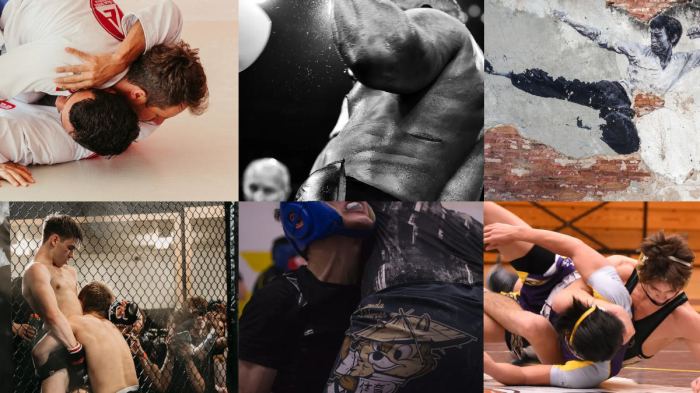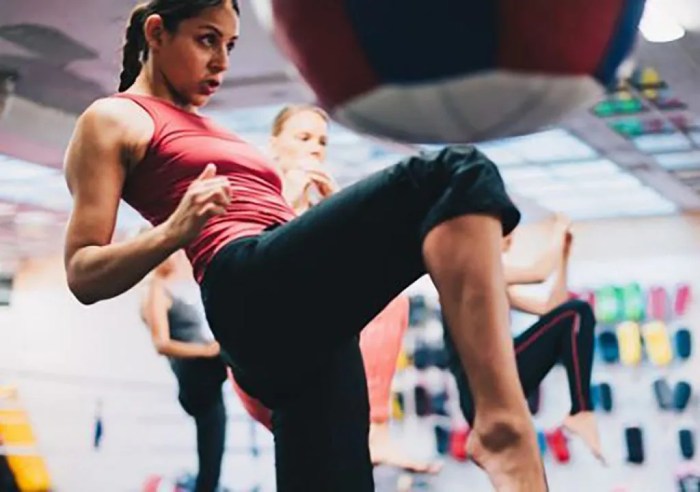
Martial arts for self-defense unfolds as a journey of empowerment, blending physical prowess with mental resilience. This practice not only equips individuals with practical techniques to handle real-life threats but also instills confidence and discipline. Whether you’re facing a potential confrontation or simply looking to boost your self-esteem, martial arts provide an invaluable toolkit for navigating the challenges of personal safety.
From the psychological benefits that enhance focus and calmness to the diverse styles that cater to various preferences, martial arts training offers something for everyone. Techniques drawn from disciplines like Brazilian Jiu-Jitsu, Krav Maga, and Muay Thai are not just about fighting; they’re about learning to read situations, making informed decisions, and advocating for oneself in a world that often seems unpredictable.
Importance of Martial Arts for Self-Defense
Martial arts training plays a crucial role in self-defense, offering not only physical skills but also psychological advantages. Understanding how martial arts can empower individuals to protect themselves and build confidence is vital in today’s unpredictable environment. The combination of physical techniques with mental preparedness equips practitioners to face real-life threats head-on.Psychological benefits of martial arts training extend beyond mere self-defense.
Training helps in developing self-discipline, focus, and resilience. Participants often experience a boost in self-esteem, which can reduce anxiety and fear in threatening situations. The mental conditioning involved in martial arts fosters a mindset that encourages calmness and strategic thinking, which are essential during emergencies. This psychological strength is as important as the physical techniques learned.
Application of Martial Arts Techniques in Real-Life Situations
Martial arts techniques are not only theoretical; they can be practically applied in various real-life scenarios. The skills acquired through consistent training can effectively address common threats, allowing individuals to respond appropriately.The following techniques demonstrate effective applications in self-defense situations:
- Striking Techniques: Techniques such as punches, kicks, and elbows can be utilized to deter an attacker and create an opportunity for escape.
- Joint Locks and Throws: Styles like Judo and Brazilian Jiu-Jitsu teach practitioners how to use an opponent’s force against them, allowing smaller individuals to defend effectively.
- Situational Awareness: Training emphasizes the importance of being aware of one’s surroundings, helping individuals to avoid potential threats before they escalate.
Effective Martial Arts Styles for Self-Defense
Several martial arts styles stand out when it comes to their effectiveness for self-defense, each offering unique advantages based on their techniques and philosophies. Identifying a suitable style can significantly enhance a person’s ability to protect themselves.The following martial arts styles are recognized for their self-defense capabilities:
- Krav Maga: Developed by the Israeli military, Krav Maga focuses on real-world situations and teaches practitioners to neutralize threats quickly and efficiently.
- Muay Thai: Known as the “Art of Eight Limbs,” this style utilizes punches, kicks, elbows, and knees, making it effective in close-quarter combat.
- Brazilian Jiu-Jitsu: This style emphasizes ground fighting and grappling techniques, allowing practitioners to defend against larger opponents by using leverage and technique.
- Self-defense Karate: Variants of traditional Karate are often adapted for self-defense, incorporating quick strikes and defensive techniques tailored for real-life encounters.
“The best defense is to be aware of your surroundings and avoid confrontation whenever possible.”
Legal Issues Surrounding Self-Defense
Understanding self-defense laws is crucial for martial arts practitioners who may find themselves in a situation requiring defensive action. Legal frameworks vary widely between jurisdictions, but generally, self-defense laws allow individuals to protect themselves from harm. However, the application and interpretation of these laws can be complex, and practitioners must navigate these legal waters with caution.The legal implications of using martial arts techniques in self-defense scenarios hinge on several factors, including the level of threat perceived, the proportionality of the response, and the context of the confrontation.
Engaging in physical defense must be justified within the confines of the law, noting that excessive force can lead to criminal charges or civil liabilities. Thus, understanding these nuances is critical for anyone trained in martial arts.
Overview of Self-Defense Laws
Self-defense laws establish the guidelines under which individuals can legally defend themselves. These laws typically cover the following key points:
- Imminent Threat: A person must demonstrate that they faced an imminent threat of harm or aggression, justifying their defensive actions.
- Proportionality: The level of force used in self-defense must be proportional to the threat faced; using lethal force in response to a non-lethal threat may be deemed excessive.
- Duty to Retreat: Some jurisdictions impose a duty to retreat when safe to do so, particularly in public spaces, before resorting to force.
- Stand Your Ground Laws: In contrast, some states have “Stand Your Ground” laws that allow individuals to use force without retreating, even when they can safely escape.
- Reasonable Belief: The individual’s belief in the need for self-defense must align with what a reasonable person would conclude in similar circumstances.
Legal Implications of Martial Arts Techniques
Using martial arts techniques in self-defense scenarios can lead to legal scrutiny, particularly concerning the nature of the response. Practitioners should be aware of the following implications:
- Training and Intent: Demonstrating that any techniques used were based on legitimate training can support a self-defense claim, illustrating that the response was deliberate rather than impulsive.
- Use of Force Continuum: Understanding the use of force continuum is vital; practitioners must know when it is appropriate to escalate their response, according to the threat level they face.
- Documentation: Maintaining documentation of self-defense training and any incidents can be crucial. Such records may serve as evidence in legal proceedings.
- Witness Testimonies: The existence of witnesses can significantly impact legal outcomes, highlighting whether the response was viewed as justified or excessive by others present.
Ethical Considerations of Self-Defense in Different Cultures
Ethical views on self-defense can vary widely among cultures, influencing how martial arts practitioners approach the use of techniques in real-life situations. Cultural norms shape beliefs around violence, justice, and personal security.
- Honor and Reputation: In some cultures, defending one’s honor may be seen as a moral imperative, justifying aggressive responses to perceived slights.
- Community Responsibility: Other cultures may emphasize community over individualism, where self-defense actions should consider the impact on family and community relationships.
- Legal and Social Ramifications: The consequences of self-defense actions can differ culturally, with some societies more forgiving of defensive acts, while others impose strict penalties regardless of intent.
- Philosophical Beliefs: Philosophies such as pacifism or non-violence influence ethical considerations, leading some practitioners to avoid physical confrontation at all costs.
Comparison of Martial Arts with Other Sports for Self-Defense

Martial arts offer a unique set of skills tailored specifically for self-defense situations, making them distinct from other sports. While many sports focus on teamwork, strategy, or physical fitness, martial arts blend discipline, mental fortitude, and practical combat skills aimed at personal protection. This comparison will shed light on how martial arts stack up against team and strength sports in terms of self-defense effectiveness.
Effectiveness of Martial Arts Versus Team Sports for Self-Defense
Martial arts training emphasizes individual self-defense skills, self-discipline, and situational awareness, which are vital in real-life confrontations. Team sports, such as soccer or basketball, primarily focus on collaboration, strategy, and collective goal achievement. While team sports foster agility, speed, and teamwork, they do not inherently prepare individuals for self-defense scenarios. In martial arts, practitioners learn techniques that apply directly to defending against attacks, including striking, grappling, and escape maneuvers.
The emphasis on reaction timing and distance management in martial arts is crucial for self-defense, which rarely allows for the strategic planning often seen in team sports.
Differences in Training Methods Between Martial Arts and Strength Sports
Training methods in martial arts significantly differ from those in strength sports such as weightlifting. Strength sports focus primarily on increasing muscle mass and power through repetitive lifting techniques. In contrast, martial arts training includes a combination of physical conditioning, technique practice, and situational drills designed to prepare the practitioner for unexpected confrontations.The training environment in martial arts often involves sparring and self-defense simulations that mimic real-life scenarios, which encourages adaptability and quick thinking.
This practical application is essential, as it allows practitioners to experience the nuances of controlling an opponent’s movement and responding to actual threats, while strength sports prioritize isolated strength gains.
Benefits of Martial Arts Versus Water Sports for Self-Defense Readiness
The following table Artikels the key benefits of martial arts compared to water sports in terms of self-defense readiness. While water sports offer physical fitness and coordination, they lack the direct application of self-defense techniques.
| Aspect | Martial Arts | Water Sports |
|---|---|---|
| Self-Defense Techniques | Direct training in techniques for self-defense and personal safety. | No direct application; focuses on recreational activities. |
| Situational Awareness | Emphasizes awareness of surroundings and threat assessment. | Limited awareness skills; focus on navigating water environments. |
| Physical Conditioning | Improves strength, agility, balance, and coordination. | Enhances cardiovascular fitness but not specific to combat readiness. |
| Mental Fortitude | Builds confidence, discipline, and mental resilience. | Develops teamwork and communication skills. |
| Real-Life Application | Skills applicable in unexpected physical confrontations. | Primarily recreational; low relevance to self-defense. |
Final Conclusion

In summary, martial arts for self-defense is not merely a physical activity; it is a holistic approach to personal empowerment and safety. By understanding the psychological and legal implications of self-defense as well as how martial arts compare with other sports, practitioners can better prepare themselves for real-world situations. Embracing martial arts fosters a sense of community and respect, proving that the journey of learning self-defense is as significant as the skills acquired along the way.
Commonly Asked Questions
What is the best martial art for self-defense?
While the best martial art can vary by individual preference, Krav Maga and Brazilian Jiu-Jitsu are often recommended for their practical applications in self-defense scenarios.
Can martial arts help with anxiety or stress?
Yes, martial arts practice can significantly reduce anxiety and stress by promoting physical activity, focus, and mindfulness.
How long does it take to learn self-defense techniques?
The time to learn effective self-defense techniques varies, but many can be grasped within a few weeks of consistent training.
Is self-defense legal in all situations?
Self-defense laws vary by jurisdiction, and it’s essential to understand the legal implications and boundaries of self-defense in your area.
Do I need to be in shape to start martial arts training?
No, martial arts can be adjusted to suit all fitness levels, and training can actually help improve your overall fitness over time.





